Indira Gandhi: the Second Phase (January 1980 - October 1984) - UPSC PDF Download
Indira Gandhi: the Second Phase (January 1980 - October 1984)
In the January 1980 General Elections, the Congress (I) secured a decisive victory, returning Indira Gandhi to power with a robust majority. Elected from Rae Bareilly and Medak, she opted for the latter and assumed the position of Prime Minister once more. Indira Gandhi, relying heavily on her son Sanjay, faced a tragic setback in June 1980 when he perished in a plane accident. Struggling with grief, she reluctantly turned to her elder son, Rajiv Gandhi, an airline pilot with no political experience. Despite initial reluctance, Rajiv entered politics and was elected from Amethi to the Lok Sabha, marking the beginning of a new phase for the Gandhi family. 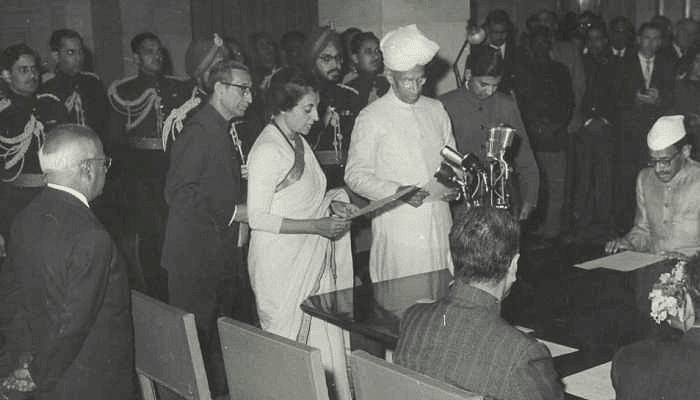 Indira Gandhi taking oath as Prime Minister of India
Indira Gandhi taking oath as Prime Minister of India
Economy and Environment
Economic Initiatives
- Indira Gandhi promptly addressed economic concerns by curbing the Janata Sixth Five-Year Plan and introducing a new Sixth Five-Year Plan (1980-85).
- The focus of the new plan centered on boosting growth, promoting industrialization, reducing poverty, and alleviating unemployment.
- A minimum needs program targeted the economically underprivileged, aiming to ensure nationally accepted standards across the country.
Rural Development Programs
- The Integrated Rural Development Programme (IRDP) was initiated nationwide on October 2, 1980.
- The National Rural Employment Programme (NREP), launched in October 1980, became a regular feature under the Plan from April 1981.
- The establishment of the National Bank for Agriculture and Rural Development in 1982, as recommended by the Shivaraman Committee, aimed at rural sector development.
Economic Liberalisation and Caution
- The Sixth Plan took cautious steps toward economic liberalization, marked by the launch of Operation Forward in 1982.
- Indira Gandhi, however, expressed apprehension about multinational companies potentially undermining the country's self-reliance.
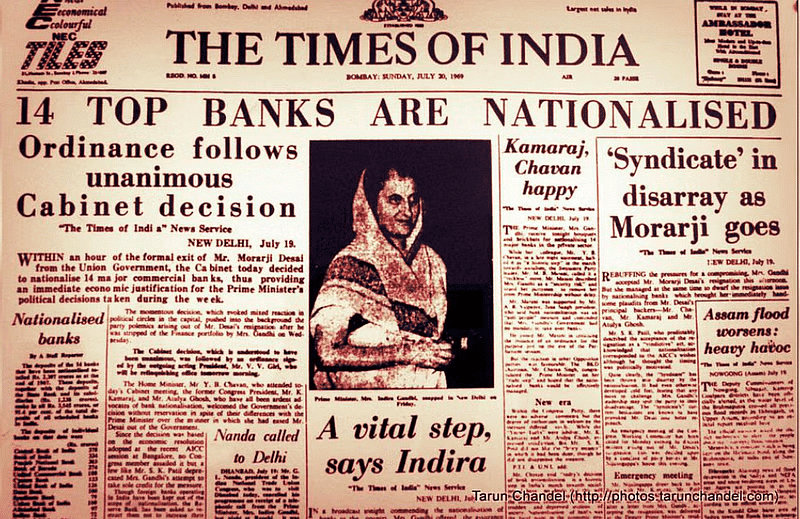 Times of India
Times of India
Environmental Conservation
- Indira Gandhi's commitment to environmental issues continued from her earlier tenure. She played a pivotal role in the implementation of the Wildlife Protection Act (1972) and the Water (Prevention and Control of Pollution) Act (1974).
- The Sixth Plan underscored environmental improvement, leading to the enactment of the Forest (Conservation) Act in 1980 and the Air (Prevention and Control of Pollution) Act in 1981.
Legacy of Previous Initiatives
- Indira Gandhi's involvement in the first UN conference on environment in 1972 laid the foundation for subsequent environmental policies.
- Projects like Project Tiger, launched in 1973, showcased her commitment to wildlife protection and environmental conservation.
India's Man in Space
During Indira Gandhi's rule, in 1984, Indian Air Force pilot Rakesh Sharma became the first Indian in space through a joint program with the Soviet Intercosmos. On Soyuz T-11, he spent eight days on the space station Salyut 7, conducting experiments in biomedicine and remote sensing. A memorable moment was when Indira Gandhi asked Sharma about India's view from space, and he responded, "Sare jahan se achcha", a sentiment that would have gone viral today!!!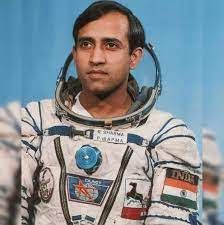 Wing Commander Rakesh Sharma
Wing Commander Rakesh Sharma
Foreign Relations
Sri Lanka and Tamils' Problem
- In Sri Lanka, power shifted from Srimavo Bandaranaike to J.R. Jayawardene, whom Indira Gandhi perceived as a Western puppet.
- Allegations arose that India, under Indira, supported LTTE militants in the 1980s to pressure Jayewardene to consider Indian interests.
- Despite alleged support, Indira Gandhi resisted calls for India to intervene in Sri Lanka following the tragic events of Black July 1983, where Sinhalese mobs targeted Tamils.
Pakistan: Siachen Conflict
- India-Pakistan relations strained under General Muhammad Zia-ul-Haq in Pakistan (1978), with suspicions of Pakistani support for Khalistani militants in Punjab.
- Military skirmishes in 1984 escalated into the Siachen Conflict, focusing on the glacier in the disputed Kashmir region, crucial for both countries.
- The conflict, rooted in territorial demarcation issues, led to Operation Meghdoot (April 1984), making Siachen the world's highest battlefield.
- India secured passes Sia La and Bilfond La, while Pakistan retained control of Gyong La.
Operation Meghdoot Map
Non-Aligned Movement
- Under Indira Gandhi, India reasserted itself in the Non-Aligned Movement.
- India hosted the 1983 Summit of NAM in Delhi, with Indira Gandhi serving as its chairperson.
- Indira emphasized the link between disarmament and economic development, advocating for a new international economic order favoring developing countries.
Unrest in the States
- Political and communal tensions surged across India during this period. Naxalite activities resurged in the tribal regions of Andhra Pradesh.
- In the Jharkhand region, part of Bihar, there was a movement for separate statehood, accompanied by similar but less intense movements in Madhya Pradesh and Uttar Pradesh. Various states sought greater autonomy. In Assam, the All-Assam Students Union demanded Bengalis leave, fearing cultural domination.
- In Nagaland, the National Socialist Council of Nagaland (NSCN), led by Muivah, advocated separatism, collaborating with militants from Kashmir and Sikh groups.
 Thuingaleng Muivah ( General Secretary of NSCN)
Thuingaleng Muivah ( General Secretary of NSCN) - In 1982, a new political party, the Telugu Desam, was formed in Andhra Pradesh by N.T. Rama Rao, a popular film star. The party came to power in the state after the assembly elections in 1982.
Punjab Turmoil and Operation Blue Star
- In the 1980s, Punjab faced intense political turmoil with deep communal divides. Sikhs, feeling a distinct religious identity, resented the central interference preventing their political party, the Akalis, from ruling the state autonomously. The Anandpur Resolution of 1973, seeking greater autonomy, subtly suggested a 'Sikh nation,' fueling interpretations of separation from the Indian Union.
- The Akalis, opposing Nirankari Sikhs, witnessed the rise of Jarnail Singh Bhindranwale. As the priest and head of the Damdami Taksal, he vehemently criticized the Nirankaris and made speeches against perceived slavery in independent India, mocking Hindus and 'modern' Sikhs. Allegedly supported by the Congress initially to counter the Akalis, Bhindranwale soon gained an independent following.
 Jarnail Singh Bhindranwale
Jarnail Singh Bhindranwale
- In 1980, the Akalis suffered a setback, losing power to the Congress. The idea of forming a separate Sikh state, mainly Khalistan, gained momentum from Sikhs abroad, particularly in England, the US, and Canada. In June 1980, students at the Golden Temple in Amritsar declared the formation of Khalistan, with Jagjit Singh Chauhan from London slated to be its president.
- As Bhindranwale gained power, suspicions arose about his involvement in assassinations, including those of Nirankari leaders. To counter him, the Akalis took extreme measures, with their legislators resigning en masse from the state assembly on Republic Day of 1983.
- Bhindranwale's virulent speeches against Hindus and his encouragement of violence against them escalated communal tensions, leading to unexpected conflict between Hindus and Sikhs.
- Efforts by the central government, led by a team including Narasimha Rao, to negotiate peace with Bhindranwale failed. Khalistani terrorists, reportedly supported by Pakistan, began entrenching themselves in Punjab, targeting prominent officials of both Hindu and Sikh backgrounds.
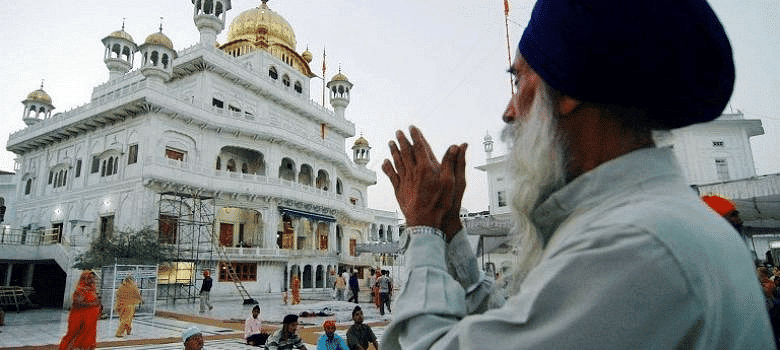 Akal Takht, Amritsar
Akal Takht, Amritsar
- In October 1983, a bus carrying Hindu passengers was stopped, and passengers were shot, prompting the imposition of President's Rule on the state. Bhindranwale, fortified in the Akal Takht near the Golden Temple, continued his activities.
- In response to the escalating situation, Operation Blue Star was initiated on the night of June 5, 1984, with the army storming the Golden Temple complex. The operation, led by Major General K.S. Brar under the direction of General K. Sundarji, faced difficulties due to sophisticated weaponry and fortifications. Tanks were eventually used to regain control by June 7, resulting in casualties among militants, army personnel, and civilians.
 Major Gen. KS Brar ( Centre) led operation Blue Star
Major Gen. KS Brar ( Centre) led operation Blue Star
Aftermath
The aftermath caused significant disturbance among Sikhs globally. Many Sikhs left the Indian Army, and mutinies were reported. While Operation Blue Star effectively ended militancy in the state and cleared the Golden Temple complex of arms, it also led to the tragic assassination of Prime Minister Indira Gandhi.
Indira Assassinated
On the morning of October 31, 1984, while walking from her house to her office, Indira Gandhi was shot by her Sikh security guards, Beant Singh and Satwant Singh. Despite being rushed to the All India Institute of Medical Sciences, she did not survive. The official announcement of her death was made by All India Radio and Doordarshan in the evening.
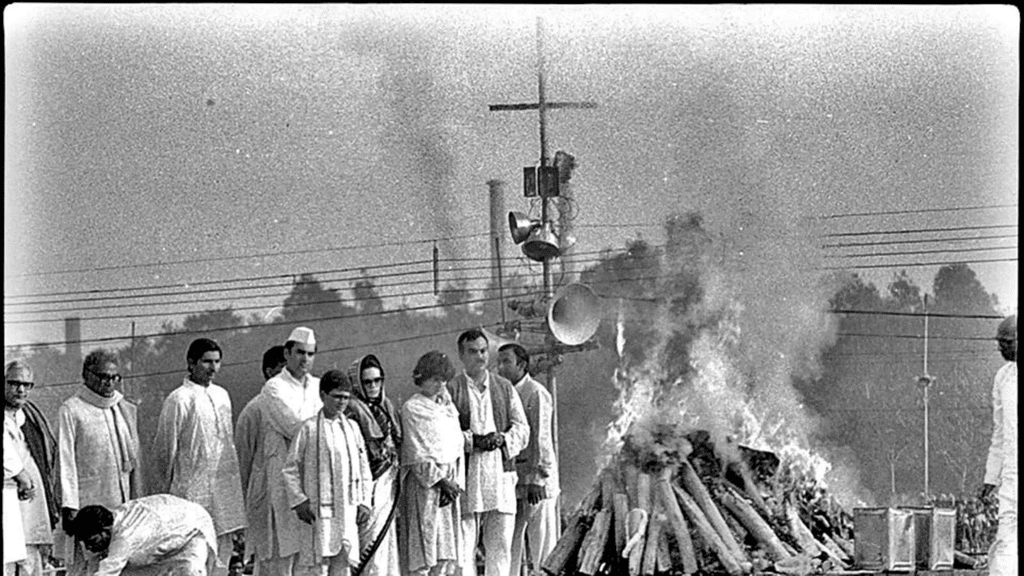 Indra Gandhi's last rites
Indra Gandhi's last rites
Legacy
The era of Indira Gandhi came to an end with her assassination. Her long tenure in power had significant implications for India.Economic and Educational Impact
- Under her leadership, economic programs and the spread of education contributed to social changes.
- The assertion of the middle and lower social castes/classes led to the growth of the middle class in urban India.
Social Unrest and Challenges
- Despite economic growth, there was widespread social unrest, caste clashes, and communal violence during her rule.
Concentration of Power and Weakening of Democratic Processes
- Indira Gandhi increasingly relied on her son and a small group of advisors.
- At the party level, she weakened the Congress party structure to avoid competitive power centers.
- Sycophancy grew, regional leaders were sidelined, and the democratic way of choosing party leadership was set aside.
- The Gandhi family became central to holding the party together, and dynastic politics became common in other parties as well.
Corruption and Abuse of Power
- Corruption grew during her tenure.
- The state apparatus was increasingly abused by those in power.
Foreign Policy and National Security
- Indira Gandhi's grit and decisiveness in the face of external aggression were exemplary.
- She demonstrated that India would not be bullied, bringing the country to prominence on the world map.
FAQs on Indira Gandhi: the Second Phase (January 1980 - October 1984) - UPSC
| 1. What was the economic situation of India during Indira Gandhi's second phase? |  |
| 2. How did Indira Gandhi contribute to India's space program? |  |
| 3. What were the major foreign relations challenges faced by Indira Gandhi during her second phase? |  |
| 4. How did the unrest in the states affect Indira Gandhi's government? |  |
| 5. What was the Punjab turmoil and Operation Blue Star? |  |














